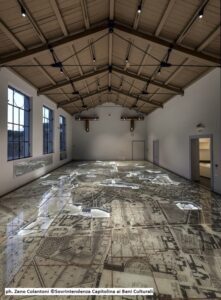Explore the ancient Rome at the new Celio Archaeological Park and Museum
by Adriana ruiz
Do you love ancient Rome? Then you will enjoy the new Celio Archaeological Park and Museum, which opened on Friday, January 12, 2024. The park and museum are on the Celio hill, where you can see many artifacts and monuments from Rome’s past.
You can visit the restored buildings in the area, such as the Casina del Salvi and the former GIL Gymnasium, where you can see the fragments of the Forma Urbis, a huge marble map of the city from the Severian age. You can also walk through the garden, where you can see various epigraphic and architectural materials from the late 19th-century excavations in Rome, organized by themes such as social life, religion, administration, and architecture.
The park and museum are in a green area facing the Colosseum and near other important archaeological sites, such as the temple of the Divo Claudio. The artifacts on display tell the history of the Capitoline Collections and Rome, the Capital of Italy, as well as the daily life of ancient Romans from different social classes and backgrounds.
You will learn about their funeral customs, their religious beliefs, their public and private buildings, their artistic skills, and their reuse and reworking of materials over time. The Celio Archaeological Park and Museum is a great place to immerse yourself in the ancient world and appreciate its legacy.
The Garden
 The Celio Archaeological Park in Rome invites you to discover the ancient history of the city and its culture through a collection of artifacts that span from the Capitoline Collections to the modern capital. You will see the results of the excavations that unearthed a wealth of objects from the new districts and their infrastructures, such as the Esquiline, Quirinal, and Viminal hills. The artifacts are arranged by themes that illustrate the daily life of ancient Rome. You will learn how different social classes expressed their status in the funeral sphere, from simple burial stones to grand tombs of senators like Servius Sulpicius Galba. You will also experience the religious sphere, from humble shrines to the gods of the Roman pantheon to majestic temples like the Temple of Castor in the Roman Forum. You will appreciate the contrast between public and private buildings, as shown by the fragments of various structures in the city, including the bases of statues that honored prominent figures in both spheres. You will also witness the administrative presence of Rome in the territory, from the markers of the Tiber’s riverbed to the extensions of the city’s pomerium, to the signs of the aqueducts’ influence. You will marvel at the architectural taste of the ancients, as revealed by the techniques of construction and decoration for buildings and marble works. Finally, you will explore the theme of reuse and reworking, a phenomenon that continued beyond antiquity and shaped the entire architectural history of the city.
The Celio Archaeological Park in Rome invites you to discover the ancient history of the city and its culture through a collection of artifacts that span from the Capitoline Collections to the modern capital. You will see the results of the excavations that unearthed a wealth of objects from the new districts and their infrastructures, such as the Esquiline, Quirinal, and Viminal hills. The artifacts are arranged by themes that illustrate the daily life of ancient Rome. You will learn how different social classes expressed their status in the funeral sphere, from simple burial stones to grand tombs of senators like Servius Sulpicius Galba. You will also experience the religious sphere, from humble shrines to the gods of the Roman pantheon to majestic temples like the Temple of Castor in the Roman Forum. You will appreciate the contrast between public and private buildings, as shown by the fragments of various structures in the city, including the bases of statues that honored prominent figures in both spheres. You will also witness the administrative presence of Rome in the territory, from the markers of the Tiber’s riverbed to the extensions of the city’s pomerium, to the signs of the aqueducts’ influence. You will marvel at the architectural taste of the ancients, as revealed by the techniques of construction and decoration for buildings and marble works. Finally, you will explore the theme of reuse and reworking, a phenomenon that continued beyond antiquity and shaped the entire architectural history of the city.
The Museum of the Forma Urbis
 At the Museum of the Forma Urbis you can see the remains of a huge map of Rome carved on 150 marble slabs between 203 and 211 AD. The map was once displayed in the Temple of Peace, and later moved to the complex of SS. Cosma and Damiano. It is a rare and precious document that shows the ancient cityscape of Rome. The map covered an area of about 18x13m, and showed more than 13,550,000 m2 of the city with detailed engravings of the buildings in Rome, at a scale of about 1:240. The map was not meant to be a practical guide, but a symbol of power and glory, giving a general view of the city and its magnificent monuments, highlighted by the use of color. The map was broken into hundreds of pieces, from 1562 to the most recent discoveries, and only about a tenth of the original map survives, in various states of preservation. Some pieces show whole neighborhoods, houses, porticos, temples, and shops, while others are just small fragments. Only about 200 pieces have been identified and matched with the modern topography. The Museum of the Forma Urbis gives you the opportunity to see the marble map in a new way, both for research and enjoyment. The museum is located in the former Gymnasium of the Italian Youth of the Lictor, which also contains a rich collection of architectural and decorative materials from the Municipal Antiquarium. The pieces of the Forma Urbis are laid on the floors of the rooms, on top of Giovanni Battista Nolli’s Large Map of 1748. You can walk through the ancient city, and admire the floor plans from a close and overhead perspective.
At the Museum of the Forma Urbis you can see the remains of a huge map of Rome carved on 150 marble slabs between 203 and 211 AD. The map was once displayed in the Temple of Peace, and later moved to the complex of SS. Cosma and Damiano. It is a rare and precious document that shows the ancient cityscape of Rome. The map covered an area of about 18x13m, and showed more than 13,550,000 m2 of the city with detailed engravings of the buildings in Rome, at a scale of about 1:240. The map was not meant to be a practical guide, but a symbol of power and glory, giving a general view of the city and its magnificent monuments, highlighted by the use of color. The map was broken into hundreds of pieces, from 1562 to the most recent discoveries, and only about a tenth of the original map survives, in various states of preservation. Some pieces show whole neighborhoods, houses, porticos, temples, and shops, while others are just small fragments. Only about 200 pieces have been identified and matched with the modern topography. The Museum of the Forma Urbis gives you the opportunity to see the marble map in a new way, both for research and enjoyment. The museum is located in the former Gymnasium of the Italian Youth of the Lictor, which also contains a rich collection of architectural and decorative materials from the Municipal Antiquarium. The pieces of the Forma Urbis are laid on the floors of the rooms, on top of Giovanni Battista Nolli’s Large Map of 1748. You can walk through the ancient city, and admire the floor plans from a close and overhead perspective.
Information:
- Entrance: Viale del Parco del Celio 20, Viale del Parco del Celio 22, Clivo di Scauro 4
- Rates:
- Archaeological Park of the Celio: Free Entry
- Museum of Forma Urbis:
- Full Resident €6.50 – Reduced Resident €5.50
- Full Non-Resident €9.00 – Reduced Non-Resident €6.50
- Free entry for MIC Roma Card holders
- Group reservations mandatory, call 060608
Tickets can be purchased online, through the call center 060608 (with a pre-sale fee of €1), or at the museum’s ticket office. On-site ticket purchases for future dates are allowed only with a credit card, with a pre-sale fee of €1.
Opening Hours:
- Archaeological Park of the Celio: Open from 7:00 to 17:30 (standard time) – from 7:00 to 20:00 (daylight saving time) Closed on December 25 and May 1
- Museum of Forma Urbis: Tuesday to Sunday from 10:00 to 16:00 Last entry one hour before closing Closed on December 25 and May 1
For More Information: Call 060608 (every day from 9:00 to 19:00)
*Images included in this articles were provided by Zeno Colantoni © Sovrintendenza Capitolina ai Beni Culturali.
Read more about:
Free entry to museums and archaeological sites in Italy on the first Sunday of each month
15 Must-Visit Museums, Galleries, and Cultural Sites in Italy
Pay a visit to Rome’s ice skating rinks
Learn about Rome Winter Sales 2024
Don’t forget to check out our Social Media accounts and Subscribe to our Newsletter so you can be updated with information customized for people who want to move, live, and love Italy! Also, check out these unique tours in Rome.
FAQs for Italian Citizenship by Marriage (2023)
Understanding the Tessera Sanitaria: Your Italian Health Insurance Card
Non-Married Partners: How to Obtain a Residence Permit in Italy as De Facto Cohabitants
How to get tax identification number for foreign citizens (Codice Fiscale)
How to register in Italy as an EU citizen
Mastering Public Transport in Italy
The Advantages of Dual Citizenship with an Italian Passport: Unlocking Boundless Opportunities
What you need to know about Visas and Permits to stay in Italy








Leave a Comment:
You must be logged in to post a comment.